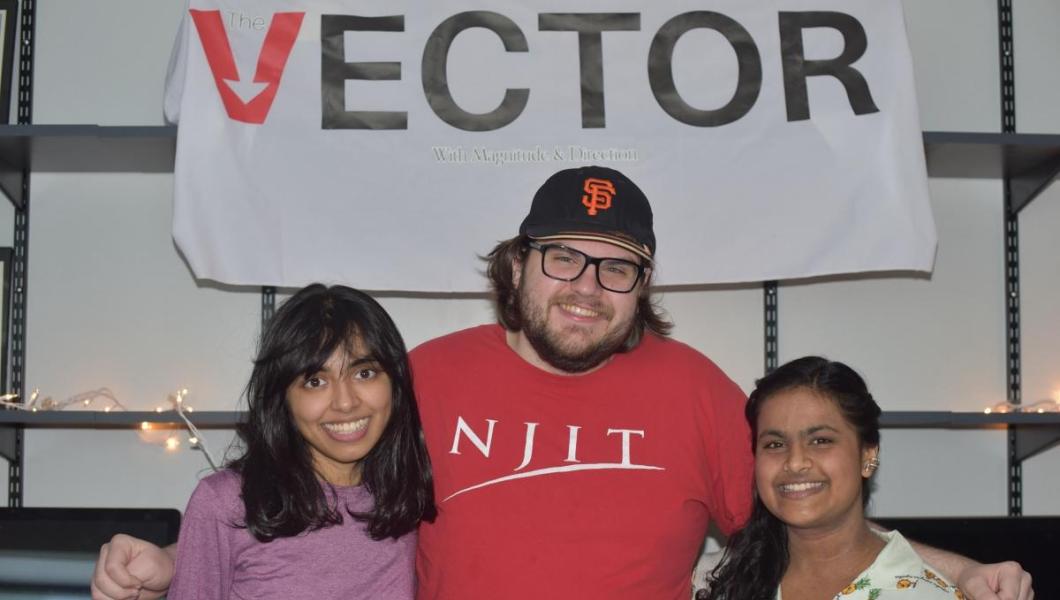Honors Team Taps Inventive Skills to Help Handi-capable Dancer
The call was put out to NJIT’s Albert Dorman Honors College (ADHC) this past spring and nine Dorman Scholars answered it. Their charge was to design and construct a tap-dance board for a handi-capable wheelchair user — a patient at Mount Sinai Health System in Manhattan who would be participating along with able-bodied dancers in the inaugural performance of the nonprofit, all-abilities dance troupe, Tap: On Tap. The performance was held at the hospital Oct. 25 in observance of World Stroke Day and National Disability Employment Awareness Month.
The show incorporated the Tap Dancing Hands Down® system, where an individual wears gloves outfitted with taps and executes the tap steps with his/her hands on a kitchen cutting board. Mary Six Rupert, a professor of tap at Wagner College and former Rockette, created the unique tap-board solution and has used the system in her work with stroke and spinal-cord-injury patients at Mount Sinai (she is behind the formation of Tap: On Tap as well). But because the performance would require a board that could be attached to a wheelchair and move freely instead of sitting stationary on the dancer’s legs — or on a table as is done traditionally with Tap Dancing Hands Down® — some modifications were necessary.
That’s when Tomlee Lahayil Abraham ’99 ’00, an Honors College, science, technology and society, and management alumnus, who today is vice chair of administration and health system administrator of the Kimberly and Eric J. Waldman Department of Dermatology at the Icahn School of Medicine at Mount Sinai, experienced a light bulb moment.
“It was just clear as day to me. We needed a solution and NJIT is all about innovation,” said Abraham, also a student of Rupert’s and a dancer in Tap: On Tap. “And as an alumnus, why would I not come to NJIT for help and support? … I knew how NJIT prepared everyone to think in very practical, real-world types of ways. … An NJIT student knows how to get things done.”
Led by Lauren Hutnik, now at Rutgers New Jersey Medical School, the ADHC team included Birju Dhahuk, Thinuri Fernando, Joshua Gaughan, Zean Go, Ryan Madden, Sandra Raju, Tyler Rodriguez and Sophia Tran. The group conducted site visits and interfaced with Abraham, Rupert and the handi-capable wheelchair user, Stephanie (pictured above with the students and Rupert), to develop the project plan and then create and test the tap-dance board.
Rupert came up with the Tap Dancing Hands Down® system more than a decade ago, initially for her mother, a tap instructor who had a stroke that significantly curtailed her mobility. “I could see her going over tap choreography in her head with no way to execute it,” remembered Rupert. “She and I tap danced using Tap Dancing Hands Down® several times before she died.”
The Tap: On Tap dance troupe that is using the system breaks down barriers through inclusivity and adaptation, said Abraham. Modification was indeed central to the effort of the ADHC team, which needed to devise a solution that could attach a tap board to different wheelchair sizes and styles.
With a budget of $125 and a tight turnaround — just two months from the first project meeting to delivery in April before rehearsals started in May — the students began by brainstorming design ideas, both through descriptions and drawings. They kept in regular touch via the messaging app GroupMe and convened regularly to analyze proposals and decide their final direction. Next, they ordered pipes, clamps and other materials and met at NJIT’s Makerspace to assemble their solution. They also visited the hospital to measure Stephanie’s wheelchair and ensure the built device fit properly on it.
Honors Tap Board Team.IMG_0040.JPG
The challenges, said Hutnik, were “finding a flexible joint that would allow the user to move the device away or closer in the x-direction without having to take the item off and reassemble,” as well as designing “a device that was sturdy and would not move around too much while the user was tapping/dancing on it.”
Also important was the ability to remove the device quickly and easily, added Gaughan ’22, a mechanical engineering major.
The team needed to ensure the user’s comfort, too. “Stephanie had a unique wheelchair and we had to find a good place on the chair to attach the device … [so it] would not get in the way of her normal movements,” Hutnik pointed out.
Abraham and Rupert are thrilled with the result, which they note stays firmly in place while enabling the handi-capable dancer to freely tap with her fellow performers. And with rehearsals and the performance having gone well, and feedback from Stephanie nothing short of glowing — the students were amazing and made sure everything was OK, and the board was perfectly situated on their device, she said — the project has been a win-win for all involved.
“How often is it you come up with something and nail it?” Abraham commented.
“Tap: On Tap’s debut was such a success. Thanks to the NJIT students, Stephanie was able to dance with the other members of the company and she enjoyed every minute of it,” added Rupert, also giving props to her great group of dancers.
Hutnik, who hopes to work with other organizations on medical-related projects, found the experience highly gratifying. “I really supported Tap: On Tap’s vision and innovative goals to make tap dancing a fun, all-inclusive activity. … Being involved from start to finish in a project and to see a vision come to life and succeed is extremely rewarding.”
“It’s one of the first real-world projects I’ve done for someone else,” said Gaughan. “This project was very rewarding, because we got to see firsthand how our work had a great impact.”

